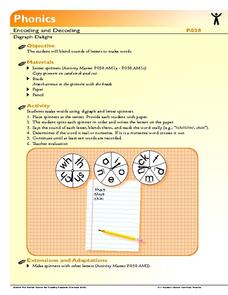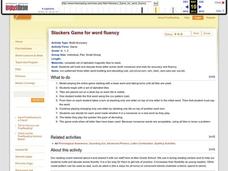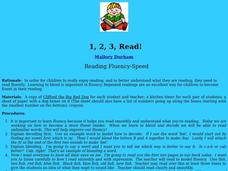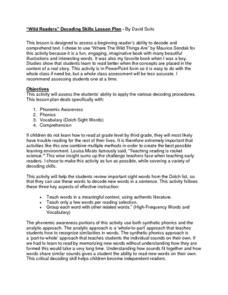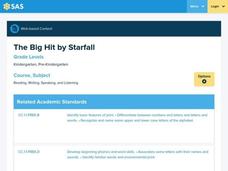National Institute for Literacy
Making Sense of Decoding and Spelling
Go over digraphs, vowel sounds, and affixes with a series of decoding and spelling lessons. Each lesson guides learners through a different reading and phonics skill, building on the lesson before, and challenging them with each step.
Curated OER
Reading Strategies for Decoding Tricky Words
Help primary school pupils learn valuable reading strategies. As they choral read a poster or big book, they predict covered words and learn various reading strategies for figuring out an unknown word. This will help them gain an...
Florida Center for Reading Research
Phonics: Encoding and Decoding, Digraph Delight
There are three spinners to use in this phonic activity. Spinner one contains digraphs, spinner two contains vowels, and spinner three contains consonants. Learners spin each spinner, write down the letters they get, blend them to make a...
Florida Center for Reading Research
Phonics: Encoding and Decoding, Vowel Stars
Learners are given a star; each star contains a c_c form in the center and vowels on each point. They use the vowels to fill in the blank between the consonants making a simple CVC word. They write each word they make on a piece of paper.
Florida Center for Reading Research
Phonics: Encoding and Decoding, Letter Cube Blending
Emergent readers use a letter cube to identify, blend, and make words. They roll each of the three-letter cubes, mark down the letters they rolled, then blend the letter sounds together to make a word. They record each word on a...
Florida Center for Reading Research
Phonics: Encoding and Decoding, Three-In-One
Scholars use the provided pack of alphabet cards to construct basic CVC words, then write down each word they make in one of two columns. Column one is for real words and column two is for nonsense words.
Florida Center for Reading Research
Phonics: Encoding and Decoding, Make-A-Word
Little learners place a picture card on a magnetic board, say the name of the object on the card, then sift through alphabet magnets to find and spell the word they said.
Florida Center for Reading Research
Phonics: Encoding and Decoding, A Digraph A Word
Learners view a series of images, then choose digraphs, consonants, and vowels to spell out the object's name on each card.
Curated OER
Lee and the Bee Flee to the Tree
Practice the strategy of decoding to become fluent readers with young scholars. They interact with the correspondence ee=/E/ as it deals with speech and text. The tongue twister, "Why did Lee and the bee flee to the tree?," is also...
Curated OER
I Feel the Need to Read!: Growing Independence and Fluency
This series of activities lets the class observe and demonstrate a variety of strategies for decoding and reading fluently with expression. They listen to the teacher read passages from If You Give a Pig a Pancake with and without...
Curated OER
Fun With Fluency
Practice reading with fluency by blending words together. To start, prepare flash cards with pseudowords on them (words that can be pronounced but have no real meaning), and work with the class to sound out the words using known...
Curated OER
Sounding Out Words
For this CVC words review worksheet, writers examine six pictures and sound out the words that identify each of them. Spaces are provided to write three letters per picture. You might want to give hints as some of the pictures are harder...
Curated OER
Stackers Game for Word Fluency
Explore words by building and decoding three-letter words. Real or nonsense words can be formed with the alphabet tiles. Practice fluency and blending sounds with CVC patterns.
Curated OER
1, 2, 3, Read!
Explain to your readers a variety of decoding strategies to improve their reading fluency. They observe the teacher modeling blending, then in pairs take turns reading the book Clifford the Big Red Dog. Learners then time each other...
Reading Resource
Painting Sentences
Paint with the colors of reading! Learners in special education classes or mainstream classes practice decoding basic and advanced code with a series of sentences on paint blobs. Once they read the sentence, learners cover one spot on...
Curated OER
School-Home Links: Reading Words
In this early childhood reading words learning exercise, students sound out 5 letter combinations and then read the words with the consonant cluster. Students identify 5 words that begin with th.
Curated OER
Amazing As
Help young readers recognize the short vowel /a/ in written and spoken language. Through matching and listening activities, they discriminate the vowel sound /a/ from other phonemes. Learners associate the phoneme with its letter...
Curated OER
Phonics: Decode and Write Words with the “Silent e”
What happens when I add an 'e' to the word mad? It becomes made! Decoding and writing words with the silent e is the lesson plan for today. The class discusses what the e can do to a cvc word, then they practice adding e's to various...
Florida Center for Reading Research
Word Steps
Blending basic CVC letters to make words is one of the first steps to independent reading. Provided here are several images of stairs and several letters to cut and arrange. The learner rearranges the letters to form CVC patterns, sounds...
David Suits
“Wild Readers” Decoding Skills Lesson Plan
Set young readers on the path toward fluency with this phonemic awareness resource. Based on the award-winning children's book, Where the Wild Things Are, this lesson allows beginning readers to practice isolating phonemes and...
Curated OER
Christmas Secret Message Puzzle
In this decoding the message worksheet, students fill in the blanks using the letters that match each Christmas picture on the page. Students write 19 letters.
Curated OER
The Big Hit
Students are introduced to the phonetic sound associated with the short letter "i" and listen to a story which includes words with this sound. In this the big hit starfall lesson, students build sound letter accuracy. Students also...
Curated OER
Using the Sounds of Words Reading Task
Young readers demonstrate phonemic awareness in words and blends, and recognize 100 high-frequency words. Use a nursery rhyme to point out rhyming words, and change the words by putting a new letter at the beginning. Each learner will...
Curated OER
Quick and Sticky Context Clues
Discuss strategies for defining word your young readers don't know. They read sentences with key words covered by sticky notes and guess from the context what the word might be. They peek at the first letter and guess again.
Other popular searches
- Decoding Unfamiliar Words
- Decoding Long Words
- Decoding Multisyllabic Words
- Decoding Accented Words
- Decoding Animal Words
- Decoding Vowel Words
- Decoding Spelling Words
- Decoding Multi Syllable Words
- Decoding Greek Latin Words
- Decoding Big Words
- Decoding Polysyllabic Words
- Decoding Unknown Words




